Development of Green Storable Hybrid Rocket Propulsion Technology Using 98% Hydrogen Peroxide as Oxidizer
Abstract
:1. Introduction
2. Technology Development Initiation—The First Steps
3. Materials and Methods Relevant to Hybrid Rocket Motor Hot Fire Testing
3.1. Development Steps and Relevant Methods
3.2. Overview of the Flight Hybrid Rocket Motor of the ILR-33 AMBER
3.3. Overview of the ILR-33 AMBER Suborbital Rocket
4. Results
4.1. Subscale Testing of Fuels for Use with 98% Hydrogen Peroxide
4.2. Full-Scale Testing of the ILR-33 AMBER Hybrid Propulsion System
4.3. In-Flight Test Campaigns
4.4. Other Actions
5. Discussion of Test Firing and Flight Testing Results
- Subscale tests cannot be directly used for full-scale design and analysis (they shall be compensated for scale differences).
- Careful measurement and data analysis is a must for obtaining reliable results for making valuable conclusions and design decisions.
- HTP of 98% concentration allows for safe handling; however, special measures must be taken in order to ensure that organics are not in contact with HTP.
- Hybrid rocket propulsion using 98% HTP can allow for efficient use for space transportation due to its higher performance than in the case of utilizing lower HTP concentrations (performance was verified in flight and extensive system performance data were obtained during in-flight and ground testing; 6-degree-of-freedom flight numerical simulations confirm that for full oxidizer loading of the ILR-33 AMBER 2K vehicle, flights above the Von Karman line will be possible).
6. Conclusions
Author Contributions
Funding
Institutional Review Board Statement
Informed Consent Statement
Data Availability Statement
Acknowledgments
Conflicts of Interest
References
- Karabeyoglu, A. Hybrid Rocket Propulsion for Future Space Launch. In Aeronautics and Astronautics 50th Year Anniversary; Space Propulsion Group Inc.: Sunnyvale, CA, USA, 2008. [Google Scholar]
- Okninski, A. On use of hybrid rocket propulsion for suborbital vehicles. Acta Astronaut. 2018, 145, 1–10. [Google Scholar] [CrossRef]
- Frota, O.; Ford, M. Review on Hybrid Propellants. ESA Spec. Publ. 2004, 557, 33.1. [Google Scholar]
- Karabeyoglu, A. Challanges in the Development of Large-Scale Hybrid Rockets. Int. J. Energ. Mater. Chem. Propuls. 2017, 16, 243–261. [Google Scholar] [CrossRef]
- Mukunda, H.S.; Jain, V.K.; Paul, P.J. A review of hybrid rockets: Present status and future potential. Proc. Indian Acad. Sci. Sect. C Eng. Sci. 1979, 2, 215–242. [Google Scholar]
- Altman, D. Hybrid rocket development history. In Proceedings of the 27th Joint Propulsion Conference, Sacramento, CA, USA, 24 June 1991. [Google Scholar]
- Altman, D.; Holzman, A. Overview and history of hybrid rocket propulsion. Prog. Astronaut. Aeronaut. 2007, 218, 1. [Google Scholar]
- Calabro, M. Overview on hybrid propulsion. Progr. Propuls. Phys. 2011, 2, 353–374. [Google Scholar]
- AIAA. Fundamentals of Hybrid Rocket Combustion and Propulsion; Kuo, K.K., Chiaverini, M.J., Eds.; American Institute of Aeronautics and Astronautics: Reston, VA, USA, 2007; ISBN 978-1563477034. [Google Scholar]
- Carmicino, C. Special Issue “Advances in Hybrid Rocket Technology and Related Analysis Methodologies”. Aerospace 2019, 6, 128. [Google Scholar] [CrossRef] [Green Version]
- Marquardt, T.; Majdalani, J. Encouraging Tests of Hybrids Hold Hope of Safer, Reliable Access to Space; AIAA: Reston, VA, USA, 2020; p. 53. [Google Scholar]
- Schmierer, C.; Kobald, M.; Tomilin, K.; Fischer, U.; Schlechtriem, S. Low cost small-satellite access to space using hybrid rocket propulsion. Acta Astronaut. 2019, 159, 578–583. [Google Scholar] [CrossRef]
- Macklin, F.; Grainger, C.; Veno, M.; Benson, J. New Applications for Hybrid Propulsion. In Proceedings of the 39th AIAA/ASME/SAE/ASEE Joint Propulsion Conference and Exhibit, Huntsville, Alabama, 20–23 July 2003. [Google Scholar]
- Jens, E.T.; Cantwell, B.J.; Hubbard, G.S. Hybrid rocket propulsion systems for outer planet exploration missions. Acta Astronaut. 2016, 128, 119–130. [Google Scholar] [CrossRef]
- Chandler, A.A.; Cantwell, B.J.; Scott Hubbard, G.; Karabeyoglu, A. Feasibility of a single port Hybrid Propulsion system for a Mars Ascent Vehicle. Acta Astronaut. 2011, 69, 1066–1072. [Google Scholar] [CrossRef]
- Parissenti, G.; Pessana, M.; Gaia, E.; Zaccagnino, E.; Santilli, F.; Pavarin, D.; Bettella, A.; Ronningen, J.-E.; Van Put, P.; Tijsterman, R. Throttleable hybrid engine for planetary soft landing. In Proceedings of the 4th European Conference for Aerospace Sciences (EUCASS 2011), Saint Petersburg, Ruassia, 4–8 July 2011. [Google Scholar]
- Whitmore, S.A.; Merkley, S.L.; Spurrier, Z.S.; Walker, S.D. Development of a Power Efficient, Restartable, “Green” Propellant Thruster for Small Spacecraft and Satellites. In Proceedings of the Small Satellite Conference, Logan, UT, USA, 10–13 August 2015. [Google Scholar]
- Lips, H.R. Experimental Investigation on Hybrid Rocket Engines Using Highly Aluminized Fuels. J. Spacecr. Rockets 1977, 14, 539–545. [Google Scholar] [CrossRef]
- Ciezki, H.; Werling, L.; Negri, M.; Strauss, F.; Kobald, M.; Kirchberger, C.; Freudenmann, D.; Hendrich, C.; Wilhelm, M.; Petrarolo, A.; et al. 50 Years of Test Complex M11 in Lampoldshausen Research on Space Propulsion Systems for Tomorrow. In Proceedings of the 7th European Conference for Aeronautics and Space Sciences (EUCASS 2017), Milan, Italy, 3–6 July 2017; pp. 3–6. [Google Scholar] [CrossRef]
- Kaniewski, D.; Bartkowiak, B.; Matyszewski, J.; Marciniak, B.; Pakosz, M.; Nowakowski, P.; Okninski, A.; Cieslinski, D.; Rysak, D.; Skorski, M.; et al. Flight Test of the Hybdrid Rocket Propulsion System—Lessons Learned from ILR-33 Project; Association Aéronautique et Astronautique de France: Seville, Spain, 2018; Volume SP2018_357. [Google Scholar]
- Chen, Y.-S.; Wu, B. Development of a Small Launch Vehicle with Hybrid Rocket Propulsion. In Proceedings of the 2018 Joint Propulsion Conference, Cincinnati, OH, USA, 9–11 July 2018. [Google Scholar]
- Seedhouse, E. SpaceShipTwo: VSS Enterprise. In Virgin Galactic; Springer: Berlin, Germany, 2015; pp. 65–85. [Google Scholar]
- Paper Information (42082)—IAF. Available online: https://iafastro.directory/iac/paper/id/42082/summary/ (accessed on 8 August 2021).
- Schüttauf, K.; Stamminger, A.; Lappöhn, K.; Ciezki, H.; Kitsche, W. Operation of solid rockets in comparison with hybrid rockets during the STERN project. In Proceedings of the SpaceOps 2016 Conference, Daejeon, Korea, 16–20 May 2016. [Google Scholar]
- Campbell, J.; Macklin, F.; Thicksten, Z. Handling Considerations of Nitrous Oxide in Hybrid Rocket Motor Testing. In Proceedings of the 44th AIAA/ASME/SAE/ASEE Joint Propulsion Conference & Exhibit, Hartford, CT, USA, 21–23 July 2008. [Google Scholar]
- Karabeyoglu, M.A. Nitrous Oxide and Oxygen Mixtures (Nytrox) as Oxidizers for Rocket Propulsion Applications. J. Propuls. Power 2014, 30, 696–706. [Google Scholar] [CrossRef]
- Ventura, M. Long Term Storability of Hydrogen Peroxide. In Proceedings of the 41st AIAA/ASME/SAE/ASEE Joint Propulsion Conference & Exhibit, Tucson, AZ, USA, 10–13 July 2005. [Google Scholar]
- Sutton, G.P.; Biblarz, O. Rocket Propulsion Elements; John Wiley & Sons: New York, NY, USA, 2016. [Google Scholar]
- Rarata, G.; Rokicka, K.; Surmacz, P. Hydrogen Peroxide as a High Energy Compound Optimal for Propulsive Applications. Cent. Eur. J. Energ. Mater. 2016, 13, 778–790. [Google Scholar] [CrossRef]
- Wernimont, E.; Ventura, M.; Garboden, G.; Mullens, P. Past and Present Uses of Rocket Grade Hydrogen Peroxide; General Kinetics, LLC.: Aliso Viejo, CA, USA, 1999. [Google Scholar]
- Moore, G.E.; Berman, K. A Solid-Liquid Rocket Propellant System. J. Jet Propuls. 1956, 26, 965–968. [Google Scholar] [CrossRef]
- Wernimont, E.J.; Meyer, S.E. Hydrogen Peroxide Hybrid Rocket Engine Performance Investigation. In Proceedings of the 30th AIAA Joint Propulsion Conference and Exhibit, Indianapolis, IN, USA, 27–29 June 1994. [Google Scholar] [CrossRef]
- Božić, O.; Porrmann, D.; Lancelle, D.; Hartwig, A. Program AHRES and its contribution to assess features and current limitations of hybrid rocket propulsion. In Proceedings of the 63th Congress of International Astronautical Federation, IAC-12-C4, Naples, Italy, 1–5 October 2012; Volume 2. [Google Scholar]
- Osmon, R.V. An experimental investigation of a lithium aluminum hydride- Hydrogen peroxide hybrid rocket(Combustion and performance characteristics of lithium aluminum hydride/hydrogen peroxide hybrid rocket). In Chemical Engineering Progress; Symposium Series; American Institute of Chemical Engineers: New York, NY, USA, 1966; pp. 92–102. [Google Scholar]
- Heister, S.D.; Wernimont, E.J.; Rusek, J. High test peroxide hybrid rocket research. In Proceedings of the 1st Hydrogen Peroxide Propulsion Workshop, Univeristy of, Surrey, Surrey, UK, 29–31 July 1998. [Google Scholar]
- Gilmour Space Passes First Orbital Engine Tests, Aims for Suborbital Launch in 2018|SpaceTech Asia. Available online: https://www.spacetechasia.com/gilmour-space-passes-first-orbital-engine-tests-aims-for-suborbital-launch-in-2018/ (accessed on 8 August 2021).
- Tian, H.; Li, X.; Zeng, P.; Yu, N.; Cai, G. Numerical and experimental studies of the hybrid rocket motor with multi-port fuel grain. Acta Astronaut. 2014, 96, 261–268. [Google Scholar] [CrossRef]
- Lestrade, J.-Y.; Anthoine, J.; Musker, A.J.; Lecossais, A. Experimental demonstration of an end-burning swirling flow hybrid rocket engine. Aerosp. Sci. Technol. 2019, 92, 1–8. [Google Scholar] [CrossRef] [Green Version]
- Porrmann, D.; Wilken, J.; Bozic, O.; Lancelle, D. First Results of Regression Rate Measurements on Ultrasonic Basis in the Ahres Hybrid Rocket Motor. In Proceedings of the Space Propulsion, Köln, Germany, 19–22 May 2014. [Google Scholar]
- Santi, M.; Paccagnella, E.; Ruffin, A.; Barato, F.; Pavarin, D.; Misté, G.; Venturelli, G.; Bellomo, N. Development and Testing of a Long Burning Time Lab-scale Paraffin-based Hybrid Rocket Motor. In Proceedings of the 53rd AIAA/SAE/ASEE Joint Propulsion Conference, Atlanta, GA, USA, 10–12 July 2017. [Google Scholar]
- Castaneda, D.A.; Natan, B. Experimental investigation of the hydrogen peroxide—solid hydrocarbon hypergolic ignition. Acta Astronaut. 2019, 158, 286–295. [Google Scholar] [CrossRef]
- Tsujikado, N.; Koshimae, M.; Ishikawa, R.; Kitahara, K.; Ishihara, A.; Sakai, Y. An Application of Commercial Grade Hydrogen Peroxide for Hybrid/Liquid Rocket Engine. In Proceedings of the 38th AIAA/ASME/SAE/ASEE Joint Propulsion Conference & Exhibit, Indianapolis, Indiana, 26 June 2002. [Google Scholar]
- Faenza, M.; Boiron, A.J.; Haemmerli, B.; Verberne, C.J. Development of the Nucleus Hybrid Propulsion System: Enabling A Successful Flight Demonstration. In Proceedings of the AIAA Propulsion and Energy 2019 Forum, Indianapolis, IN, USA, 19–22 August 2019. [Google Scholar]
- Mayer, T.; Bartkowiak, B. Scalability Analysis of Additively Manufactured Grain for 4 kN High Test Peroxide Hybrid Rocket Motor. In Proceedings of the 8th European Conference for Aeronautics and Space Sciences (EUCASS), Madrid, Spain, 4 July 2019; pp. 1–12. [Google Scholar]
- Ahn, B.; Huh, J.; Bhosale, V.K.; Kwon, S. Three-Dimensionally Printed Polylactic Acid as Solid Fuel for Hydrogen Peroxide Hybrid Rockets. J. Propuls. Power 2021, 37, 171–175. [Google Scholar] [CrossRef]
- Technology|ARRC. Available online: https://arrc.tw/technology/ (accessed on 8 August 2021).
- SKYHY Rocket|Skyrora. Available online: https://www.skyrora.com/skyhy (accessed on 8 August 2021).
- Whitmore, S.A.; Martinez, C.J.; Merkley, D.P. Catalyst development for an arc-ignited hydrogen peroxide/ABS hybrid rocket system. Aeronaut. Aerosp. Open Access J. 2018, 2, 356–388. [Google Scholar] [CrossRef] [Green Version]
- Lestrade, J.-Y.; Anthoine, J.; Verberne, O.; Boiron, A.J.; Khimeche, G.; Figus, C. Experimental Demonstration of the Vacuum Specific Impulse of a Hybrid Rocket Engine. J. Spacecr. Rockets 2017, 54, 101–108. [Google Scholar] [CrossRef]
- Zhao, B.; Yu, N.; Liu, Y.; Zeng, P.; Wang, J. Unsteady simulation and experimental study of hydrogen peroxide throttleable catalyst hybrid rocket motor. Aerosp. Sci. Technol. 2018, 76, 27–36. [Google Scholar] [CrossRef]
- Li, C.; Cai, G.; Wang, P.; Tian, H. Flow field and injector heat characteristics of hybrid rocket motor with annular-gap injector. Aerosp. Sci. Technol. 2019, 93, 105326. [Google Scholar] [CrossRef]
- Jeong, J.; Bhosale, V.K.; Kwon, S. Ultrafast igniting, low toxicity hypergolic hybrid solid fuels and hydrogen peroxide oxidizer. Fuel 2021, 286, 119307. [Google Scholar] [CrossRef]
- Whitmore, S.A.; Armstrong, I.W.; Heiner, M.C.; Martinez, C.J. High-Performing Hydrogen Peroxide Hybrid Rocket with 3-D Printed and Extruded ABS Fuel. In Proceedings of the 2018 Joint Propulsion Conference, Cincinnati, OH, USA, 9–11 July 2018. [Google Scholar]
- Oztan, C.; Coverstone, V. Utilization of additive manufacturing in hybrid rocket technology: A review. Acta Astronaut. 2021, 180, 130–140. [Google Scholar] [CrossRef]
- Knuth, W.H.; Chiaverini, M.J.; Sauer, J.A.; Gramer, D.J. Solid-Fuel Regression Rate Behavior of Vortex Hybrid Rocket Engines. J. Propuls. Power 2002, 18, 600–609. [Google Scholar] [CrossRef]
- Kang, S.; Lee, D.; Lee, E.; Kwon, S. Design and performance evaluation of hybrid rocket using 95 wt. % H2O2. In Proceedings of the 52nd AIAA/SAE/ASEE Joint Propulsion Conference, Salt Lake City, UT, USA, 25–27 July 2016. [Google Scholar]
- Ahn, B.; Kang, H.; Lee, E.; Yun, Y.; Kwon, S. Design of Multiport Grain with Hydrogen Peroxide Hybrid Rocket. J. Propuls. Power 2018, 34, 1189–1197. [Google Scholar] [CrossRef]
- Farbar, E.; Louwers, J.; Kaya, T. Investigation of Metallized and Nonmetallized Hydroxyl Terminated Polybutadiene/Hydrogen Peroxide Hybrid Rockets. J. Propuls. Power 2007, 23, 476–486. [Google Scholar] [CrossRef]
- Akiba, R.; Nakajima, T.; Nagata, H. A New Era of the Hybrid Rocket. J. Space Technol. Sci. 2000, 16, 2.1–2.5. [Google Scholar]
- DeLuca, L.T.; Bernelli, F.; Maggi, F.; Tadini, P.; Pardini, C.; Anselmo, L.; Grassi, M.; Pavarin, D.; Francesconi, A.; Branz, F.; et al. Active space debris removal by a hybrid propulsion module. Acta Astronaut. 2013, 91, 20–33. [Google Scholar] [CrossRef]
- Lécossais, A.; Odic, K.; Fiot, D.; Lestrade, J.-Y.; Verberne, O.; Fernando, P.; Christ, P.; Searle, T. HYPROGEO Hybrid Propulsion: Latest project achievements. In Proceedings of the Space Propulsion 2018, Seville, Spain, 14–18 May 2018. [Google Scholar]
- Clark, J.D.; Asimov, I. Ignition!: An Informal History of Liquid Rocket Propellants; Rutgers University Press: New Brunswick, NJ, USA, 1972; ISBN 978-0-8135-9919-9. [Google Scholar]
- Pakosz, M.; Noga, T.; Kaniewski, D.; Okninski, A.; Bartkowiak, B. ILR-33 AMBER rocket–quick, low cost and dedicated access to suborbital flights for small experiments. In Proceedings of the 24th ESA Symposium on European Rocket and Balloon Programmes and Related Research, Essen, Germany, 16–20 June 2019. [Google Scholar]
- Cieśliński, D.; Okninski, A.; Noga, T.; Pakosz, M.; Mayer, T.; Kaniewski, D.; Florczuk, W.; Surmacz, P.; Bartkowiak, B.; Wolanski, P. ILR-33 “Amber” Rocket—A Platform For Microlauncher System Technology Development. In Proceedings of the 69th International Astronautical Congress 2018, Bremen, Germany, 1–5 October 2018. [Google Scholar]
- Ventura, M.C.; Heister, S.D. Hydrogen peroxide as an alternate oxidizer for a hybrid rocket booster. J. Propuls. Power 1995, 11, 562–565. [Google Scholar] [CrossRef]
- Lund, G.; Starrett, W.; Jensen, K. Development and lab-scale testing of a gas generator hybrid fuel in support of the Hydrogen Peroxide Hybrid Upper Stage Program. In Proceedings of the 37th Joint Propulsion Conference and Exhibit, Salt Lake City, UT, USA, 8–11 July 2001. [Google Scholar]
- Miranda, F. Design Optimization of Ground and Air-Launched Hybrid Rockets; Delft University of Technology: Delft, The Netherlands, 2015. [Google Scholar]
- Costa, F.; Contaifer, R.; Albuquerque, J.; Gabriel, S.; Marques, R. Study of Paraffin/H2O2 Hybrid Rockets for Launching Nanosats. In Proceedings of the 44th AIAA/ASME/SAE/ASEE Joint Propulsion Conference & Exhibit, Hartford, CT, USA, 21–23 July 2008. [Google Scholar]
- 90 Kilonewton Hotfire from Gilmour Space Technologies|Spaceaustralia. Available online: https://spaceaustralia.com/index.php/news/90-kilonewton-hotfire-gilmour-space-technologies (accessed on 8 August 2021).
- Messinger, T.L. Conceptual Design and Optimization of Hybrid Rockets. Master’s Thesis, Schulich School of Engineering, Calgary, AB, Canada, 2021. [Google Scholar]
- Current Programs & Technology Development Areas—Parabilis-Space. Available online: https://parabilis-space.com/programs-and-applications/#hybrid-upper-stage (accessed on 8 August 2021).
- Brown, T.R.; Lydon, M.C. Testing of Paraffin-Based Hybrid Rocket Fuel Using Hydrogen Peroxide Oxidizer. In Proceedings of the AIAA Region 5 Student Conference, Wichita, KS, USA, 14–16 September 2005. [Google Scholar]
- Whitmore, S.A.; Merkley, D.P. Arc-Ignition of a 70%-85% Hydrogen Peroxide/ABS Hybrid Rocket System. In Proceedings of the 53rd AIAA/SAE/ASEE Joint Propulsion Conference, Atlanta, GA, USA, 10–12 July 2017. [Google Scholar]
- Wernimont, E.J.; Heister, S.D. Combustion Experiments in Hydrogen Peroxide/Polyethylene Hybrid Rocket with Catalytic Ignition. J. Propuls. Power 2000, 16, 318–326. [Google Scholar] [CrossRef]
- Bozic, O.; Poppe, G.; Porrmann, D. An Advanced Hybrid Rocket Engine for an Alternative Upper Stage of the Brasilian VLM 1 LEO Launcher. In Proceedings of the 65th International Astronautical Congress, Toronto, ON, Canada, 29 September 2014. [Google Scholar]
- Huh, J.; Ahn, B.; Kim, Y.; Song, H.; Yoon, H.; Kwon, S. Development of a University-Based Simplified H2O2/PE Hybrid Sounding Rocket at KAIST. Int. J. Aeronaut. Space Sci. 2017, 18, 512–521. [Google Scholar] [CrossRef]
- Cai, G.; Zeng, P.; Li, X.; Tian, H.; Yu, N. Scale effect of fuel regression rate in hybrid rocket motor. Aerosp. Sci. Technol. 2013, 24, 141–146. [Google Scholar] [CrossRef]
- Wu, Y.; Yu, X.; Lin, X.; Li, S.; Wei, X.; Zhu, C.; Wu, L. Experimental investigation of fuel composition and mix-enhancer effects on the performance of paraffin-based hybrid rocket motors. Aerosp. Sci. Technol. 2018, 82–83, 620–627. [Google Scholar] [CrossRef] [Green Version]
- Shark, S.C.; Pourpoint, T.L.; Son, S.F.; Heister, S.D. Performance of Dicyclopentadiene/H2O2-Based Hybrid Rocket Motors with Metal Hydride Additives. J. Propuls. Power 2013, 29, 1122–1129. [Google Scholar] [CrossRef]
- Tsohas, J.; Droppers, L.J.; Glean, E.; Dambash, E.M.; Heister, S.D. Progress in technology demonstration for a small hybrid launch vehicle. In Proceedings of the 5th Responsive Space Conference, Los Angeles, CA, USA, 23–26 April 2007. [Google Scholar]
- Paccagnella, E.; Santi, M.; Ruffin, A.; Barato, F.; Pavarin, D.; Misté, G.A.; Venturelli, G.; Bellomo, N. Testing of a Long-Burning-Time Paraffin-Based Hybrid Rocket Motor. J. Propuls. Power 2019, 35, 432–442. [Google Scholar] [CrossRef]
- Franco, M.; Barato, F.; Paccagnella, E.; Santi, M.; Battiston, A.; Comazzetto, A.; Pavarin, D. Regression Rate Design Tailoring through Vortex Injection in Hybrid Rocket Motors. J. Spacecr. Rockets 2020, 57, 278–290. [Google Scholar] [CrossRef]
- Cai, G.; Zhu, H.; Rao, D.; Tian, H. Optimal design of hybrid rocket motor powered vehicle for suborbital flight. Aerosp. Sci. Technol. 2013, 25, 114–124. [Google Scholar] [CrossRef]
- Li, X.; Tian, H.; Yu, N.; Cai, G. Experimental investigation of fuel regression rate in a HTPB based lab-scale hybrid rocket motor. Acta Astronaut. 2014, 105, 95–100. [Google Scholar] [CrossRef]
- Cai, G.; Li, C.; Tian, H. Numerical and experimental analysis of heat transfer in injector plate of hydrogen peroxide hybrid rocket motor. Acta Astronaut. 2016, 128, 286–294. [Google Scholar] [CrossRef]
- Surmacz, P. Influence of various types of Al2O3/MnxOy catalysts on performance of a 100mm chamber for decomposition of 98%+ hydrogen peroxide. Trans. Inst. Aviat. 2015, 240, 58–68. [Google Scholar] [CrossRef]
- Surmacz, P.; Rarata, G. Prace badawcze i rozwojowe nad demonstratorem technologii rakietowego silnika hybrydowego wykorzystujacego 98% nadtlenek wodoru jako utleniacz. Prace Instytutu Lotnictwa 2014, 240, 51–61. [Google Scholar] [CrossRef]
- Gordon, S.; Mcbride, B.J. Computer program for calculation of complex chemical equilibrium compositions and applications. Part 1: Analysis. NASA Ref. Publ. 1994, 1311, 49. [Google Scholar]
- MatlabCEA; Purdue University, Purdue Hydrogen Systems Lab: West Lafayette, IN, USA, 2019.
- Runckel, J.F.; Willis, C.M.; Salters, L.B. Investigation of Catalyst Beds for 98-Percent-Concentration Hydrogen Peroxide; National Aeronautics and Space Administration: Washington, DC, USA, 1963.
- Rarata, G.; Surmacz, P.; Sobczak, K. Near Future Green Propellant for Space Transportation. In Proceedings of the VIII International Scientific Conference: “Development Trends in Space Propulsion Systems”, Warsaw, Poland, 14–15 November 2013; Volume 277. [Google Scholar]
- McCormick, J.C.; Lijewski, A.; Carnine, G. Storage of 90% and 98% by Weight Hydrogen Peroxide in Sealed Containers for Extended Periods; Food Machinery and Chemical Corp Becco Chemical Div: Buffalo, NY, USA, 1961. [Google Scholar]
- Quinn, J. Oxidizer Selection for the ISTAR Program (Liquid Oxygen versus Hydrogen Peroxide). In Proceedings of the 38th AIAA/ASME/SAE/ASEE Joint Propulsion Conference & Exhibit, Indianapolis, IN, USA, 26 June 200.
- Rarata, G.; Florczuk, W. Safety aspects of hypergolic propellants with hydrogen peroxide. Mater. Wysokoenergetyczne 2017, 9, 136–144. [Google Scholar] [CrossRef]
- Wolanski, P.; Folusiak, M.; Kublik, D.; Swiderski, K.; Rarata, G.; Sobczak, K.; Surmacz, P.; Florczuk, W. Techniques and Technologies of Space Rockets; Institute of Aviation: Warsaw, Poland, 2009; Available online: https://www.researchgate.net/publication/236577067_Techniques_and_technologies_of_space_rockets (accessed on 24 August 2021).
- Wolanski, P. Hybrydy silniki rakietowe na paliwo ciekło-stałe. Skrzyd. Pol. 1965, 90, 10–11. [Google Scholar]
- Rarata, G.; Surmacz, P.; Swiderski, K.; Folusiak, M.; Kindracki, J.; Wolanski, P. The model hybrid rocket motor. Computations, design and fire tests. Inf. Syst. Inf. Syst. Mech. Control Sci. Tech. Collect. 2009, 3, 69–73. [Google Scholar]
- Surmacz, P.; Rarata, G.; Wolanski, P. Development of a Hybrid Propulsion System for Attitude Control and Orbit Change of Small Satellites. In NATO AVT 171 Multifunctional Structures and Systems Technologies for Small Spacecraft; NATO: Brussels, Belgium, 2010. [Google Scholar]
- Surmacz, P.; Rarata, G. Investigation of spontaneous ignition in a 100 N HTP/HTPB hybrid rocket engine. Trans. Inst. Aviat. 2015, 240, 69–79. [Google Scholar] [CrossRef]
- Wisniowski, W.; Wolanski, P. The role of the institute of aviation in space technology research. Trans. Inst. Aviat. 2014, 234, 9–16. [Google Scholar] [CrossRef]
- Marciniak, B.; Okniński, A. Rozwój polskiego programu niewielkich rakiet sondujących. Pract. Inst. Lotnictwa 2014, 234, 82–89. [Google Scholar] [CrossRef]
- Okninski, A.; Marciniak, B.; Bartkowiak, B.; Kaniewski, D.; Matyszewski, J.; Kindracki, J.; Wolanski, P. Development of the Polish Small Sounding Rocket Program. Acta Astronaut. 2015, 108, 46–56. [Google Scholar] [CrossRef]
- Marciniak, B.; Okninski, A.; Bartkowiak, B.; Pakosz, M.; Sobczak, K.; Florczuk, W.; Kaniewski, D.; Matyszewski, J.; Nowakowski, P.; Cieslinski, D.; et al. Development of the ILR-33 “Amber” sounding rocket for microgravity experimentation. Aerosp. Sci. Technol. 2018, 73, 19–31. [Google Scholar] [CrossRef]
- Okninski, A.; Bartkowiak, B.; Sobczak, K.; Kublik, D.; Surmacz, P.; Rarata, G.; Marciniak, B.; Wolanski, P. Development of a Small Green Bipropellant Rocket Engine Using Hydrogen Peroxide as Oxidizer. In Proceedings of the 50th AIAA/ASME/SAE/ASEE Joint Propulsion Conference, Cleveland, OH, USA, 28–30 July 2014. [Google Scholar]
- Sobczak, K.M.; Surmacz, P.; Bartkowiak, B.; Okninski, A.; Rarata, G.P.; Wolanski, P.; Kublik, D.; Valencia Bel, F. Test Campaign of a Green Liquid Bi-propellant Rocket Engine Using Catalytically Decomposed 98% Hydrogen Peroxide as Oxidizer. In Proceedings of the 53rd AIAA/SAE/ASEE Joint Propulsion Conference, Atlanta, GA, USA, 10–12 July 2017. [Google Scholar]
- Surmacz, P.; Sobczak, K.; Bartkowiak, B.; Rarata, G.; Okninski, A.; Mayer, T.; Wolanski, P.; Bel, V. Development Status of 500 N-class HTP/TMPDA Bi-propellant Rocket Engine. In Proceedings of the 69th International Astronautical Congress, Bremen, Germany, 1–5 October 2018. [Google Scholar]
- Surmacz, P.; Kostecki, M.; Gut, Z.; Olszyna, A. Aluminum Oxide–Supported Manganese Oxide Catalyst for a 98% Hydrogen Peroxide Thruster. J. Propuls. Power 2019, 35, 614–623. [Google Scholar] [CrossRef]
- Surmacz, P.; Rarata, G.P.; Sobczak, K.M.; Bartkowiak, B.; Okninski, A.; Wolanski, P.; Valencia Bel, F. Experimental Evaluation of a Catalyst Bed Based on MnxOy/Al2O3 Catalyst for Decomposition of 98% Hydrogen Peroxide. In Proceedings of the 53rd AIAA/SAE/ASEE Joint Propulsion Conference, Atlanta, GA, USA, 10–12 July 2017. [Google Scholar]
- Okninski, A.; Pakosz, M.; Bartkowiak, B.; Nowakowski, P.; Noga, T.; Matyszewski, J.; Cieslinski, D.; Marciniak, B.; Kaniewski, D.; Wolanski, P. The ILR-33 AMBER 2K Rocket—Dedicated Access to Suborbital Experimentation; International Astronautical Fedration: Washington, DC, USA, 2019; Volume IAC-19,D2,6,8,x50868. [Google Scholar]
- Nowakowski, P.; Okninski, A.; Pakosz, M.; Cieslinski, D.; Bartkowiak, B.; Wolanski, P. Development of small solid rocket boosters for the ILR-33 sounding rocket. Acta Astronaut. 2017, 138, 374–383. [Google Scholar] [CrossRef]
- Spiralski, M.; Bęben, K.; Konior, W.; Cieśliński, D. High Altitude Ballooning as an Atmospheric Sounding System in the Pre-Flight Procedures of ILR-33 Amber. Trans. Aerosp. Res. 2020, 2020, 66–77. [Google Scholar] [CrossRef]
- Pakosz, M.; Matysek, K.; Nowakowski, P.; Noga, T.; Majewska, E.; Ptasinski, G. Design Modifications for Performance Enhancement of a Suborbital Rocket ILR-33 Amber 2K. In Proceedings of the 71st International Astronautical Congress (IAC)—The CyberSpace Edition, Guido, Schwartz, 12–14 October 2020; Volume IAC-20-D2.6.7. [Google Scholar]
- Ruchala, P.; Placek, R.; Stryczniewicz, W.; Matyszewski, J.; Cieslinski, D.; Bartkowiak, B. Wind tunnel investigation of the influence of boosters and fins on aerodynamic characteristics of ILR-33 Amber rocket. Trans. Aerosp. Res. 2017, 2017, 82–102. [Google Scholar] [CrossRef] [Green Version]
- Rmili, B.; Monchaux, D.; Boisneau, O.; Hassin, J.; Querry, S.; Besson, S.; Poirey, G.; Bore, R.; Hamada, I.; Amrouchi, H.; et al. FROG, a Rocket for GNC demonstrations: Firsts flights attempts of the FROG turbojet version and preparation of the future mono-propellant rocket engine. In Proceedings of the 8th European Conference for Aeronautics and Space Sciences, Madrid, Spain, 1–4 July 2019. [Google Scholar] [CrossRef]
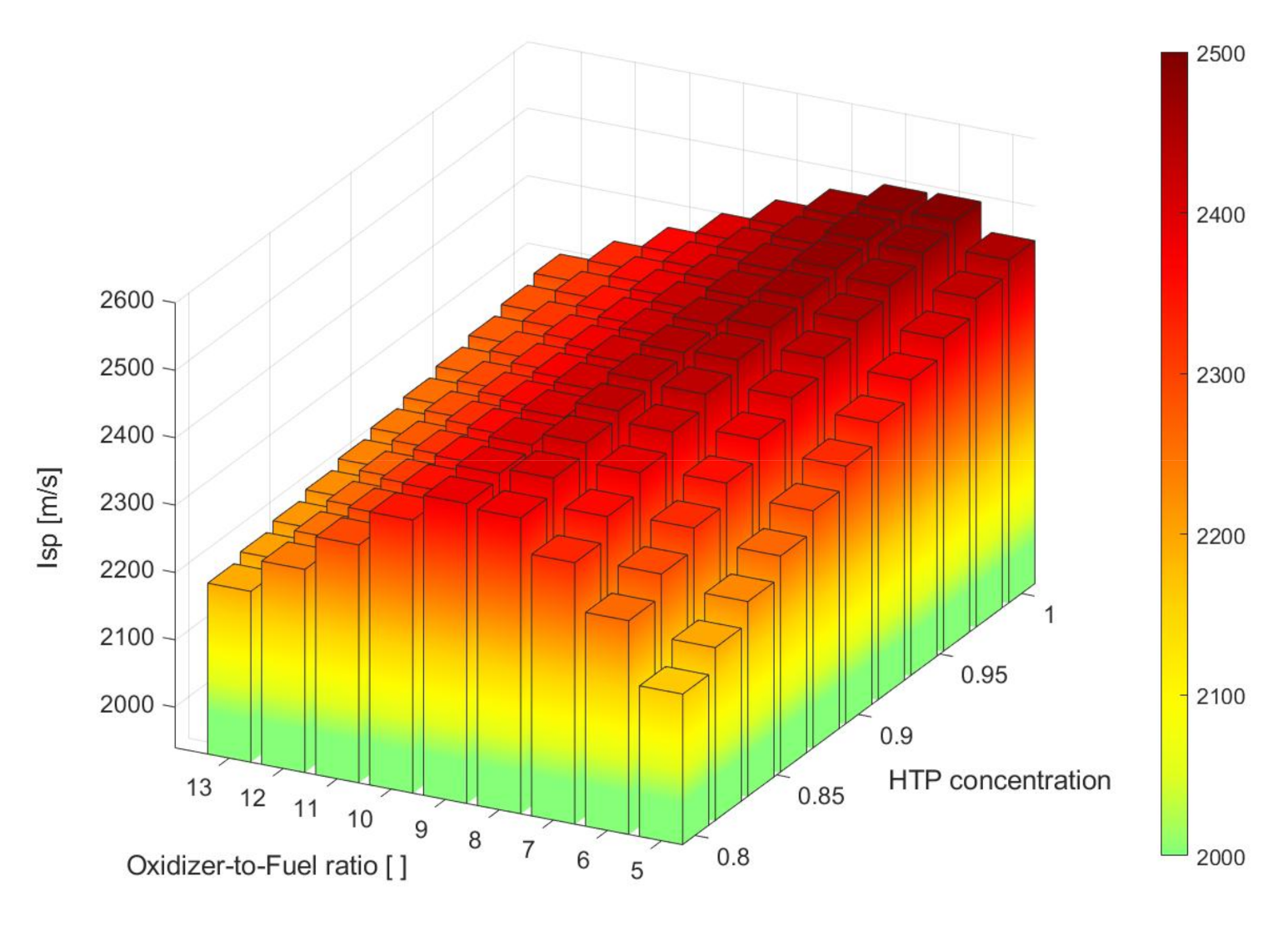
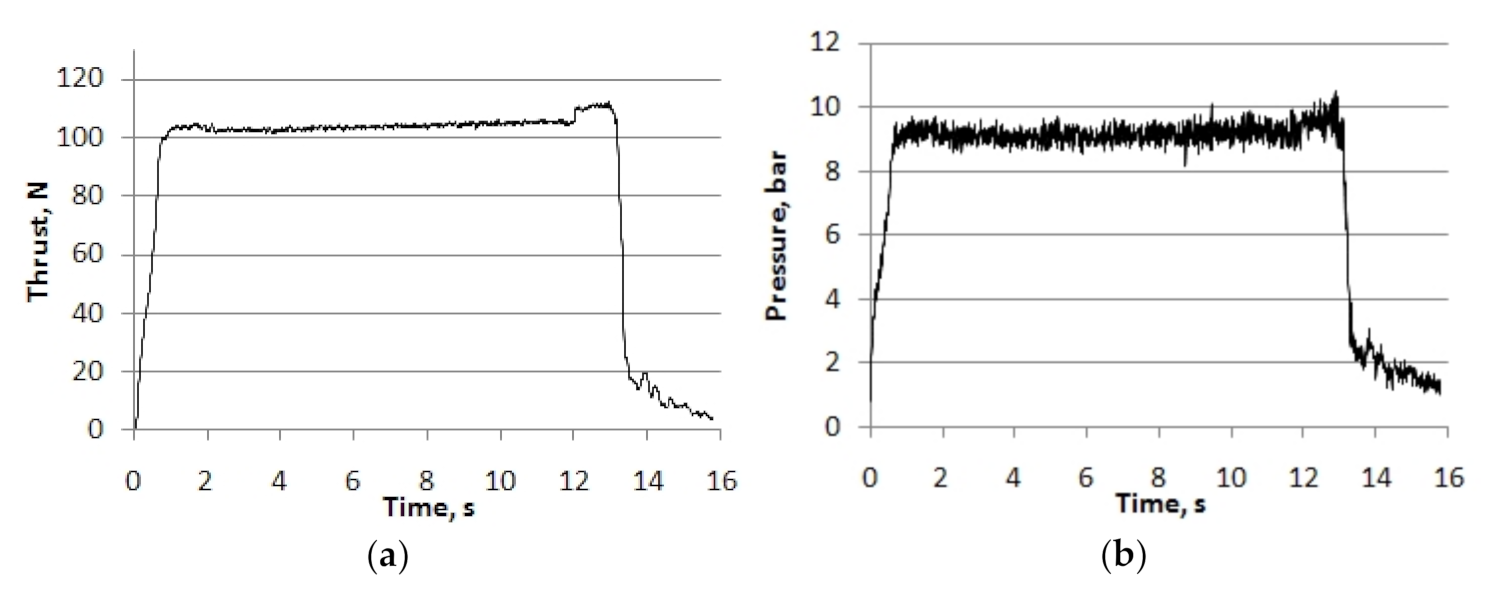
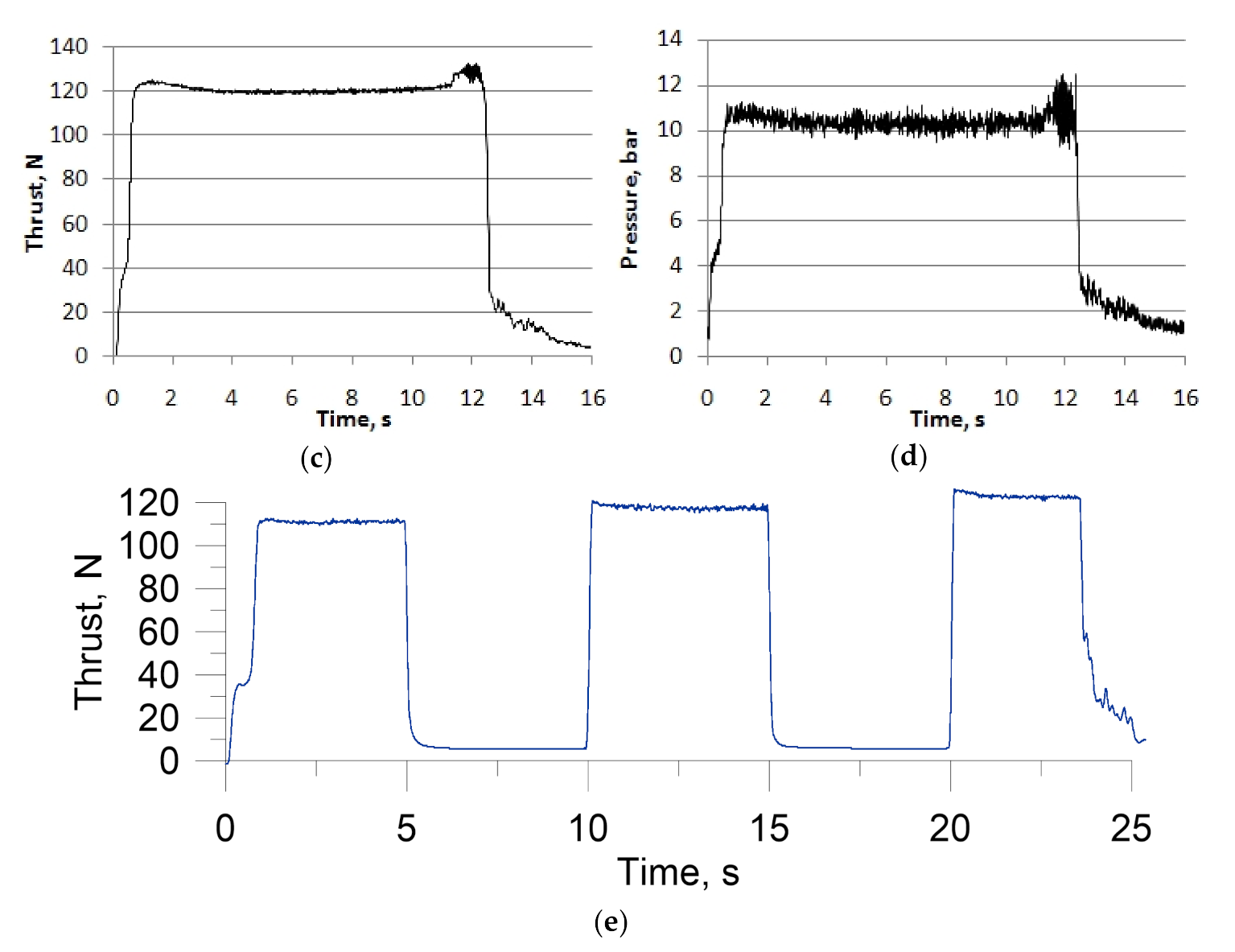
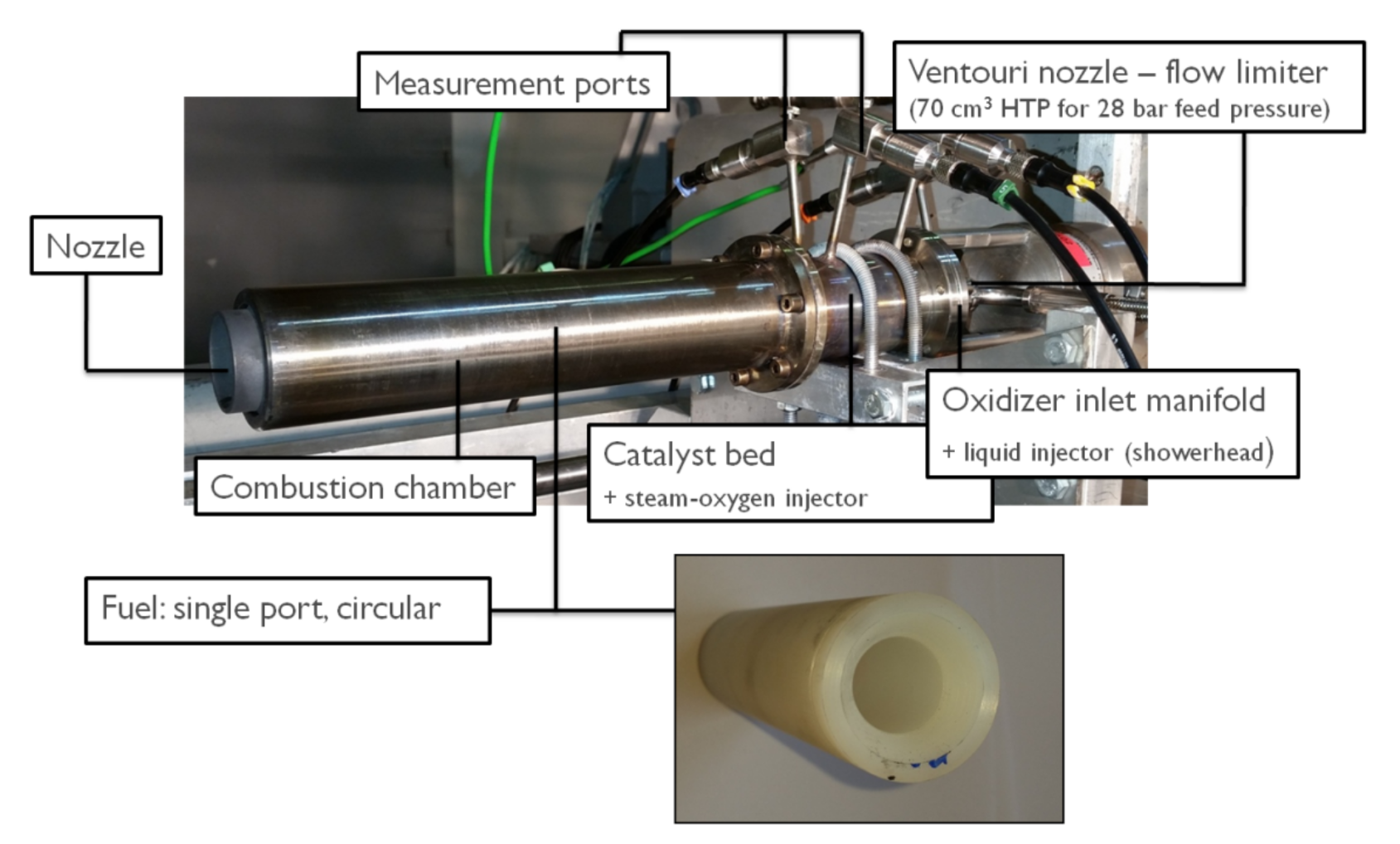
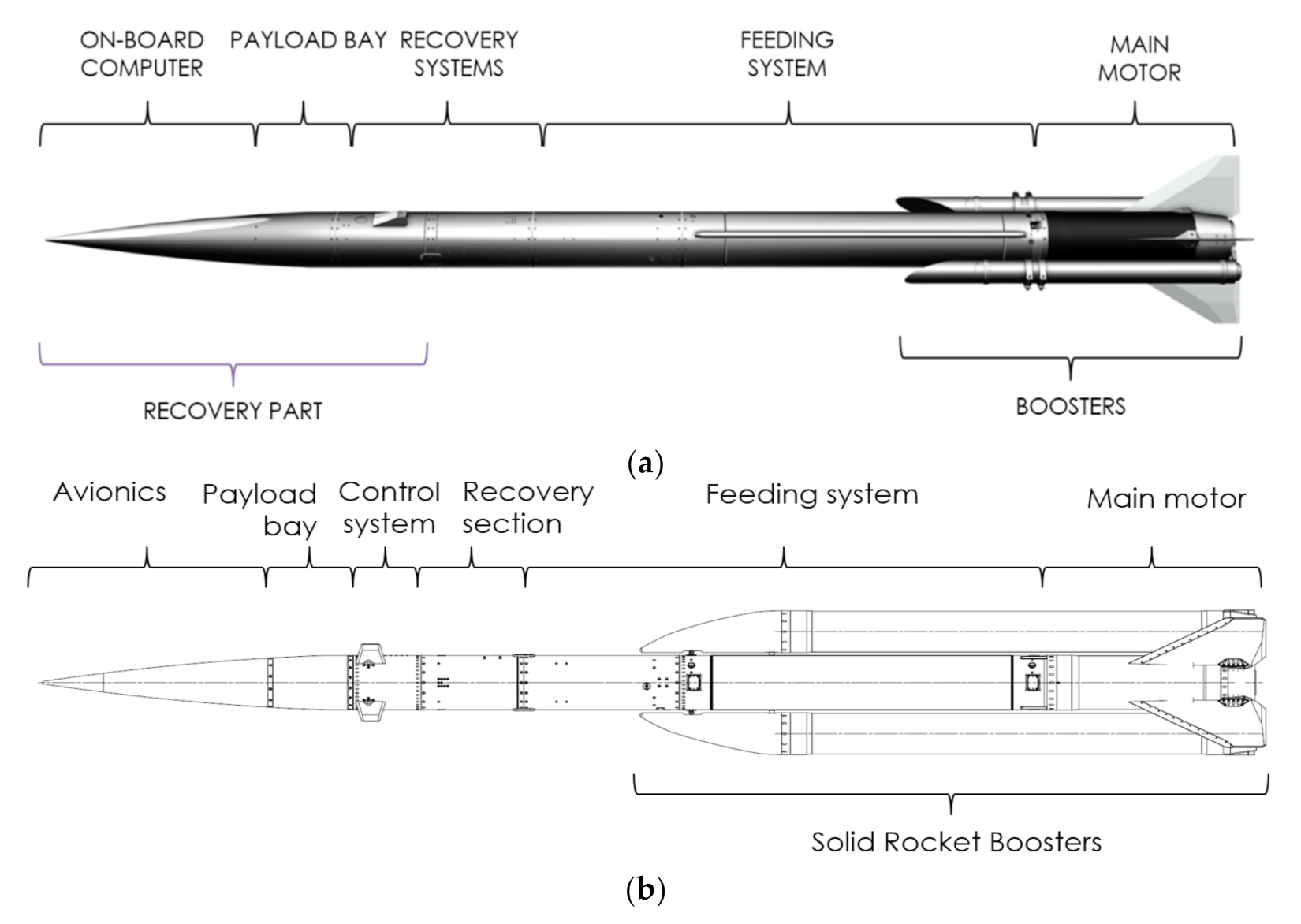

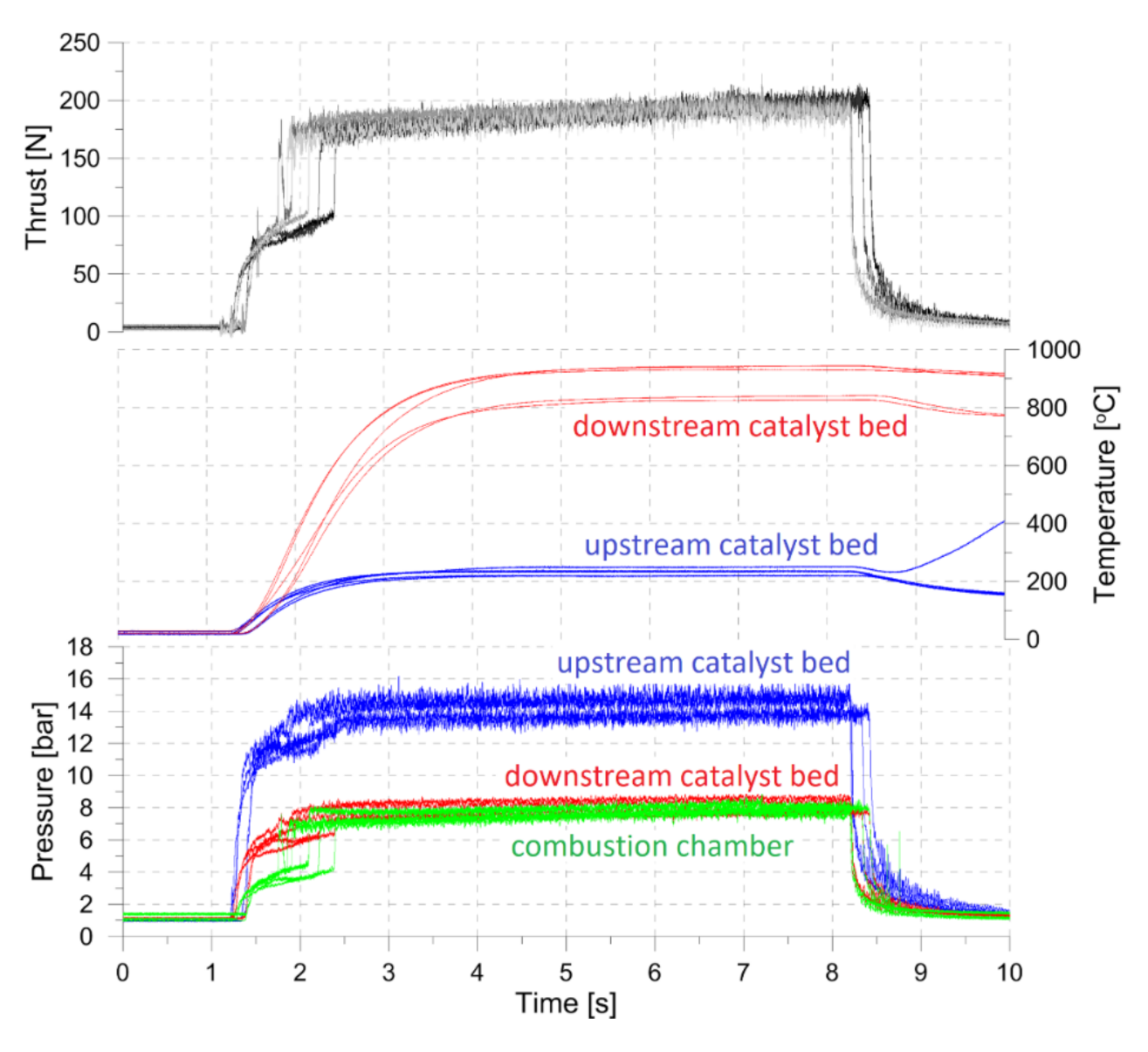
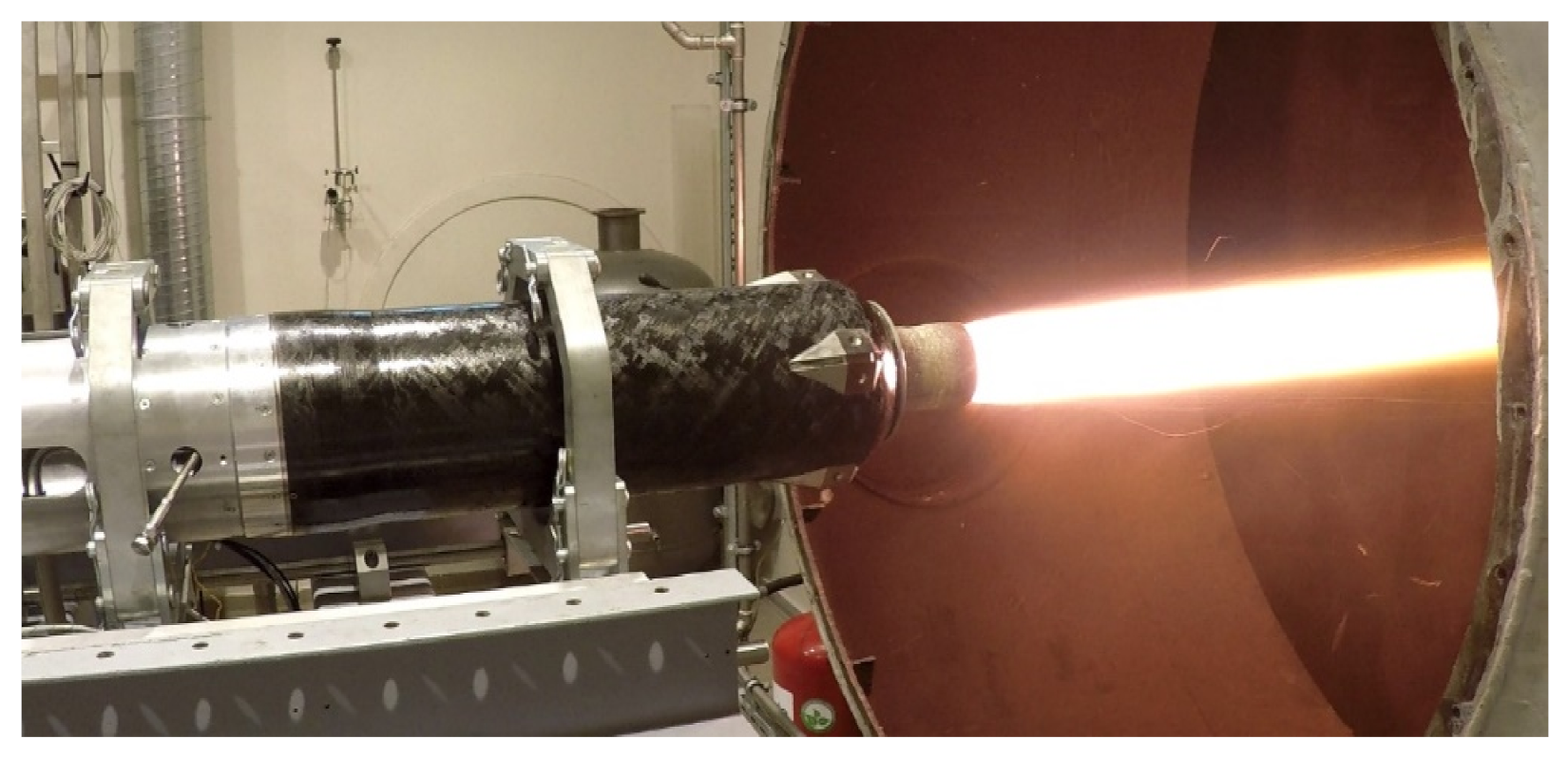


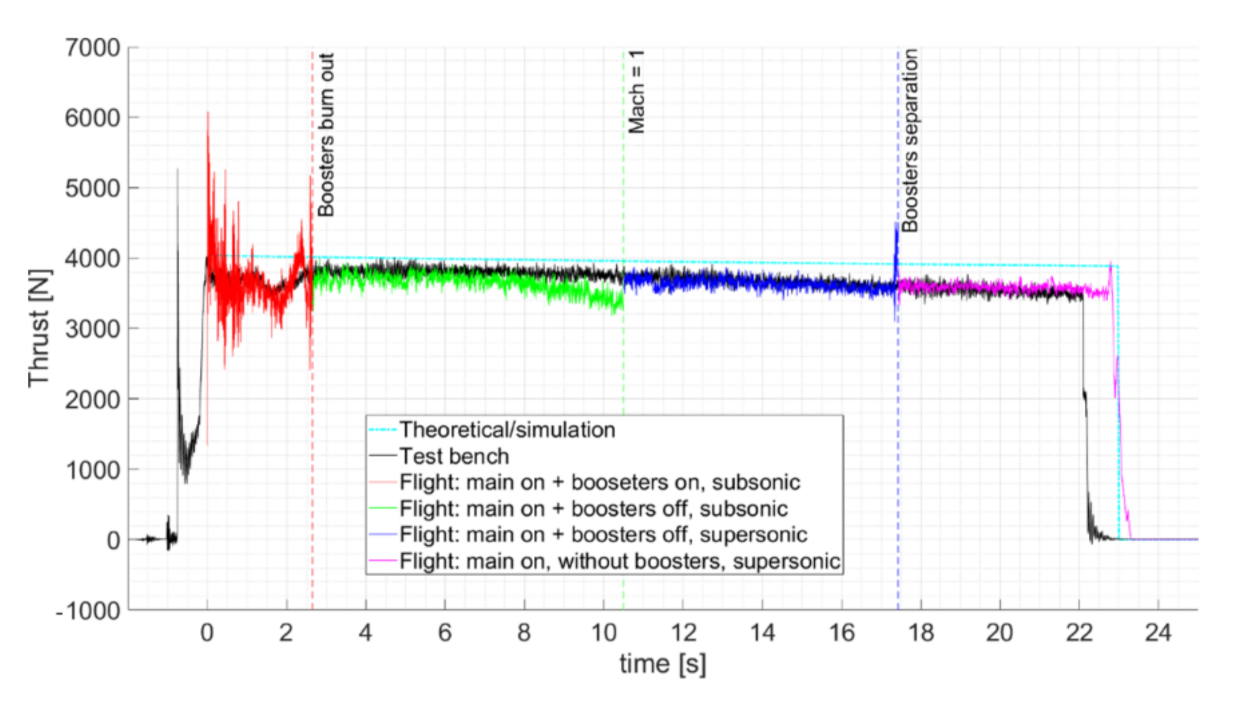
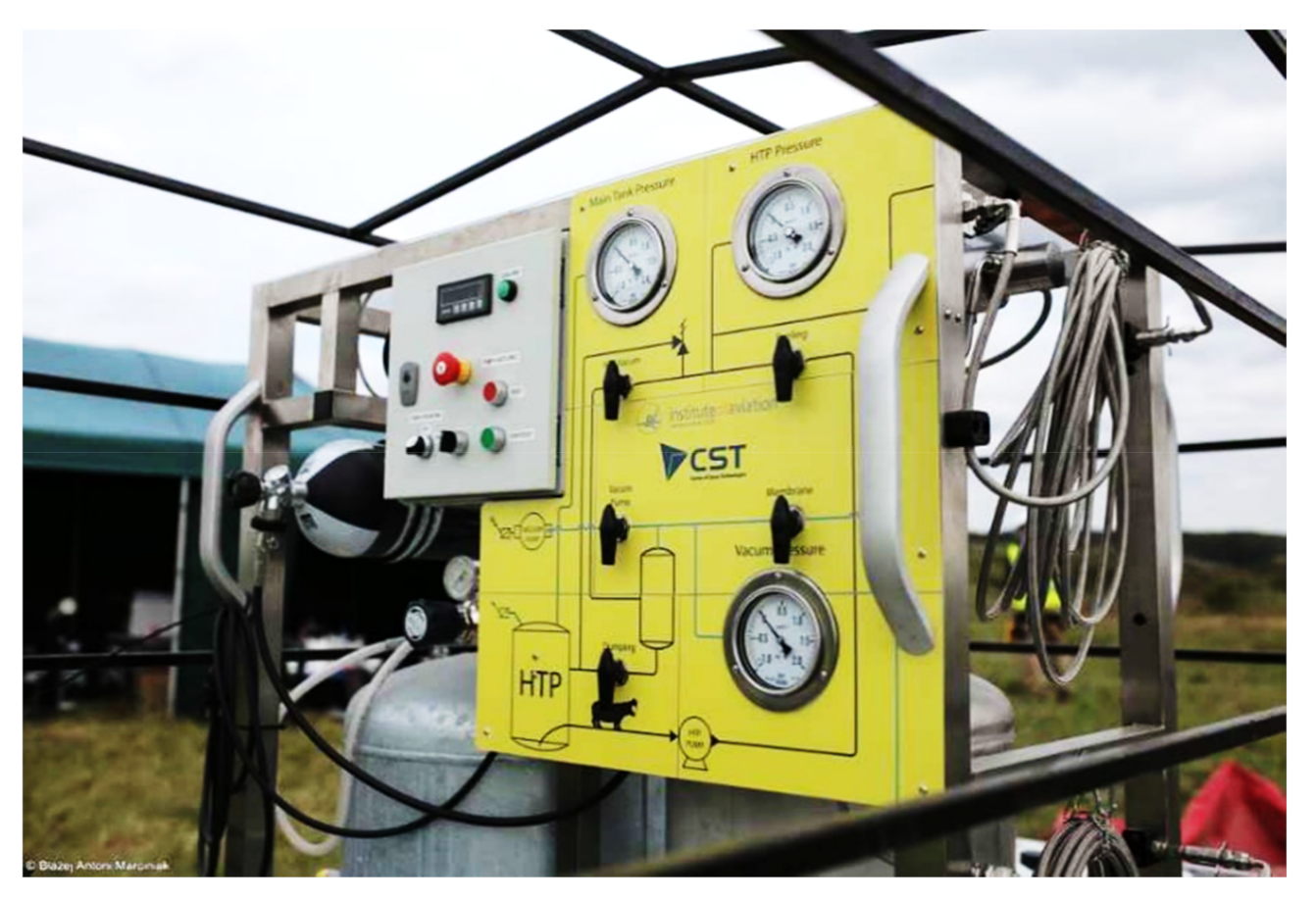
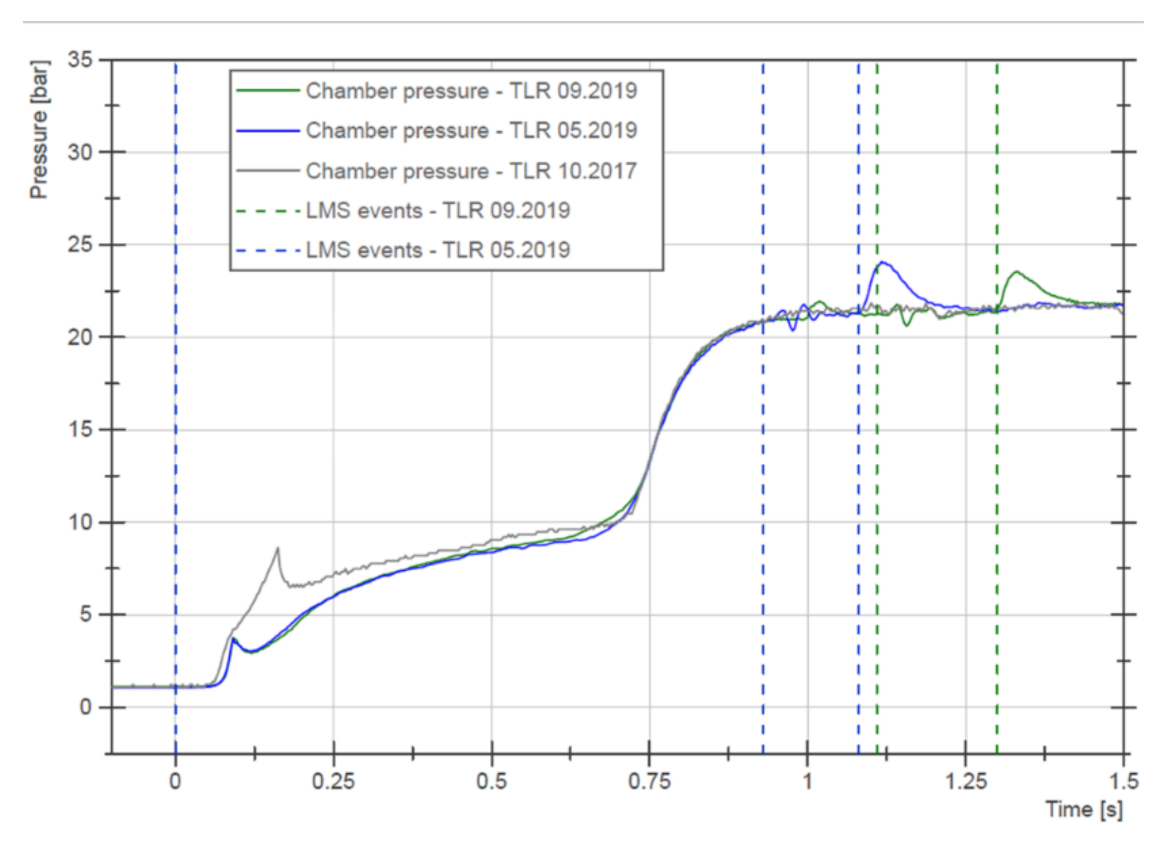

| H2O2 Concentration | Fuel | Motor Thrust 1 | Ignition System | Grain Geometry | Regression Rate Law Following Equation (1) | Injection | Reference |
|---|---|---|---|---|---|---|---|
| 70% | PE | torch | single port | [42] | |||
| 84% | Paraffin/C (95/5) | 385–661 N | catalytic | single port | 0.0344 Gox0.9593 | [72] | |
| 70–85% | ABS | arc ignition | [73] | ||||
| 80–85% | LDPE, HDPE, polymethyl methacrylate | catalytic (consumable bed) | single port | 0.040 Gox0.78 determined for LDPE for Gox in the range of 70–211 kg/(s·m2) at 6.9 bar 0.035 Gox0.52 determined for LDPE for Gox in the range of 70–211 kg/(s·m2) at 13.8 bar 0.041 Gox0.49 determined for LDPE for Gox in the range of 141–492 kg/(s·m2) at 27.6 bar | [74] | ||
| 87.5% | PE | 300 N (vacuum) | catalytic | single port | catalyst and swirl injector | [49] | |
| 87.5% | HTPB + C | 30,000 N | catalytic | multiport | [43] | ||
| 87.5% | HTPB + Al (70/30) | 2400 N | catalytic | telescope (rod-and-tube geometry) | shower-head | [75] | |
| 88% | PE | catalytic | single port | 0.0535 Gox0.8 | [32] | ||
| 85–90% | ABS | 140 N | arc-jet ignition (small catalyst bed) | single port | [48] | ||
| 90% | PE | 4450 N | catalytic | various, including telescope (rod-and-tube geometry) | ~Gox0.45 | [31] | |
| 90% | PE | 250 N | catalytic | [76] | |||
| 90% | PE | up to 1250 N | catalytic | single port | [50] | ||
| 90% | HTPB | single port | 0.04019 Gox0.5623 | shower-head | [77] | ||
| 90% | Paraffin + PE wax + EVA + SA + C (50/20/18/10/2) | 11,500 N | catalytic | single port | 0.279 Gox0.732 | [78] | |
| 90% | D: HTPB + Al (40/60)E: HTPB + Al/Mg (40/60) | 90 N | catalytic | single port | 0.014 Gox0.7 (D) 0.029 Gox0.6 (E) | porous injector to cat bed | [58] |
| 90% | Dicyclopentadiene, HTPB with metal hydrates | catalytic | single port | 0.057 Gox0.49 (DC) 0.060 Gox0.50 (HTPB) 0.019 Gox0.73 (HTPB + NaBH4: 75/25) 0.008 Gox0.90 (HTPB + NaBH4: 50/50) 0.037 Gox0.65 (HTPB + AlH3: 75/25) | [79] | ||
| 90% | HDPE, PLA, ABS | 250 N | catalytic | single port | shower-head | [45] | |
| 90% | LDPE | 4000 N | catalytic | 4-port | full cone spray | [80] | |
| 90% | LiAlH4 + PE (95/5) | [34] | |||||
| 90% | Paraffin | 1000 N | catalytic | single port | 0.145 Gox0.5 | [81] | |
| 90% | PP | 400 N | catalytic | single port | swirl | [82] | |
| 91.5% | HDPE | 300 N | catalytic | single port | provided as function of swirl number | swirl | [82] |
| 90%, 95% | HDPE | 250 N | catalytic | single port | 0.0320 Gox0.54 (90% HTP) 0.00737 Gox0.75 (95% HTP) | shower-head | [56] |
| 95% | Ammonia borane, paraffin wax and hypergolic additives | hypergolic | [52] | ||||
| 87.5%, 98% | PE | 250 N | catalytic | end-burning | 0.0446 Gox0.3288 (87.5% HTP) | annular ring swirl injection, with six catalyst beds | [38] |
| 90–98% | HTPB | 9.392 10−2 Gox0.53 (90% HTP) 9.824 10−2 Gox0.53 (98% HTP) | [83] | ||||
| 98% | HDPE | 4000 N | catalytic | wagon wheel | shower-head | [20] | |
| 98% | A: HTPB + Al (80/20) B: HTPB + C14H10 + Al (60/20/20) C: HTPB + Al + Mg + C (60/28/10/2) | 1000 N | solid propellant igniter | single port | 3.9388 10−3 Gox1.0433 (A) 4.2938 10−3 Gox1.0336 (B) 2.6676 10−2 Gox0.72493 (C) | shower-head | [84,85] |
| 98% | HTPB | 100 N | catalytic | single port | shower-head | [86,87] | |
| 98% | PE | no catalytic bed | single port | annular gap | [51] | ||
| 98% | ABS, HDPE, PA6 | 200 N | catalytic | wagon wheel | shower-head | [44] |
| Development Task | Approach | Outcome |
|---|---|---|
| fuel candidates down-selection | literature review, use of data of previous in-house test [86,87,99] | high-density polyethylene (2 variants, paraffin, polyamide (PA6) |
| fuel regression rate determination | subscale firings of laboratory hybrid rocket motors using 98% HTP and down-selected fuels (Figure 3) | regression rate formulas for each propellant combination |
| catalyst development for 98% HTP for burn durations exceeding 40 s and mass flow rates up to 1.5 kg/s | use of earlier verified catalyst technology | use of a catalyst bed using Al2O3 support and MnxOy active phase [86,107,108] |
| thermal insulation and low-regression ablative insert degradation characterization | subscale firings of laboratory motors and engines | regression rates of materials in various critical locations within the combustion chamber and nozzle assembly |
| feeding system operation and performance validation | ground-testing dynamic characteristics of pressure regulator, valves and measurement devices via feeding water using the helium pressurant | datasets of temperature and pressure in feeding system, particularly with focus on conditions in helium tank and oxidizer tank [20] |
| pre-flight motor operation and performance validation | ground firings of full-scale hybrid rocket motors | datasets of pressures, temperatures, mass flows along test-site feeding system and within the motor itself, thrust measurement and extensive data from vision systems (including fast cameras and thermovision) [20] |
| in-flight hybrid rocket motor technology verification | suborbital launch of rocket demonstrator | in-flight data of hybrid rocket motor operation 1 [20,63,109] |
| Parameter | ILR-33 AMBER | ILR-33 AMBER 2K |
|---|---|---|
| Launch mass | 160 kg | 270 kg |
| Nominal payload mass | 5 kg | 10 kg |
| Hybrid rocket motor main core total impulse (sea level) | 150 kNs | 156 kNs |
| Hybrid rocket motor main core burn duration | 40 s | 39 s |
| Solid rocket motor booster stage total impulse (sea level) | 27 kNs | 176.8 kNs |
| Solid rocket motor booster stage burn duration | 2.6 s | 6.1 s |
Publisher’s Note: MDPI stays neutral with regard to jurisdictional claims in published maps and institutional affiliations. |
© 2021 by the authors. Licensee MDPI, Basel, Switzerland. This article is an open access article distributed under the terms and conditions of the Creative Commons Attribution (CC BY) license (https://creativecommons.org/licenses/by/4.0/).
Share and Cite
Okninski, A.; Surmacz, P.; Bartkowiak, B.; Mayer, T.; Sobczak, K.; Pakosz, M.; Kaniewski, D.; Matyszewski, J.; Rarata, G.; Wolanski, P. Development of Green Storable Hybrid Rocket Propulsion Technology Using 98% Hydrogen Peroxide as Oxidizer. Aerospace 2021, 8, 234. https://doi.org/10.3390/aerospace8090234
Okninski A, Surmacz P, Bartkowiak B, Mayer T, Sobczak K, Pakosz M, Kaniewski D, Matyszewski J, Rarata G, Wolanski P. Development of Green Storable Hybrid Rocket Propulsion Technology Using 98% Hydrogen Peroxide as Oxidizer. Aerospace. 2021; 8(9):234. https://doi.org/10.3390/aerospace8090234
Chicago/Turabian StyleOkninski, Adam, Pawel Surmacz, Bartosz Bartkowiak, Tobiasz Mayer, Kamil Sobczak, Michal Pakosz, Damian Kaniewski, Jan Matyszewski, Grzegorz Rarata, and Piotr Wolanski. 2021. "Development of Green Storable Hybrid Rocket Propulsion Technology Using 98% Hydrogen Peroxide as Oxidizer" Aerospace 8, no. 9: 234. https://doi.org/10.3390/aerospace8090234
APA StyleOkninski, A., Surmacz, P., Bartkowiak, B., Mayer, T., Sobczak, K., Pakosz, M., Kaniewski, D., Matyszewski, J., Rarata, G., & Wolanski, P. (2021). Development of Green Storable Hybrid Rocket Propulsion Technology Using 98% Hydrogen Peroxide as Oxidizer. Aerospace, 8(9), 234. https://doi.org/10.3390/aerospace8090234






